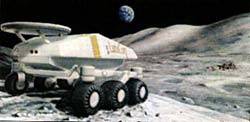LunaCorp,
a small but ambitious private company headed by its former president
David Gump, was established in 1989. The creation of the company
was inspired by the idea to launch a privately-funded lunar mission,
which would send a lunar rover, driven by commercial customers,
onto the Moon. The initial idea of LunaCorp had both scientific
and entertainment, as well as commercial value - to further explore
the Moon and to enable direct participation of the general public
in space programs. At the beginning of the program, LunaCorp was
planning to send the rover onto the
Moon with a sole purpose of visiting the landing sites of
the Apollo mission. Later plans developed towards exploration
of the sites located near the Poles, especially the shaded craters
which were believed to hide lunar supplies of frozen water. The
program's advisor was Dr. Buzz Aldrin, who, together with Neil
Armstrong, walked on the surface of the Moon in 1969 during the
first manned lunar mission.
The
planned LunaCorp program included a custom designed Moon's rover,
build by Dr. Red Whittaker in accordance with Russian technologies.
Dr. Whittaker, one of the top scientists of the Robotics Institute
of Carnegie Mellon University in Pittsburgh, had to design a lunar
vehicle of about 440 pounds, that would be operating in extreme
temperature conditions of the Moon, both boiling hot and unbearably
cold, depending on the time of the day or night. As the robot
had to explore lunar craters hidden from the Sun on the Poles
of the Moon, it had to be ready to efficiently operate in very
low temperatures of liquid nitrogen. Originally, a strategy of
LunaCorp mission to the Moon was outlined by the mission controller
Geoffrey Landis, who proposed to avoid the extreme lunar temperatures
by navigating the rover to drive along lunar high latitudes at
a low speed. Such mission strategy was designed for the robot
to both experience only mild lunar temperatures and be able to
use solar power as a source of fuel (See the work "Solar
Power for the Lunar Night" written by Geoffrey Landis
in 1989). It was planned that the robotic rover would use solar
energy when operating in the sunlight, and batteries when driving
in the shade. Additional equipment had to include a powerful drill
capable to dig up to 4 feet deep into the lunar ground in search
of water and the imaging system to transfer quality videos back
on earth. The lunar rover was scheduled to be first tested in
the severe conditions of Canadian Arctic, in July 2001. The test
had to be sponsored by NASA in the amount of $1 million. It is
known that, before the year 2000, LunaCorp had already manufactured
and tested the first Dr. Whittaker's model of lunar rover named
the Nomad. Later, the rover test in Canada was conducted, with
other subsequent tests in Atacama Desert of Chile and in Antarctica.
In
June 2000, LunaCorp published a press-release
titled "LunaCorp Launches Plan for Multimedia Moon Robot".
The document contained the scheduled year of the Icebreaker Moon
Rover launch - 2003, and named the initial corporate sponsor of
the project - RadioShack Corporation. An earlier sponsor, Japanese
giant company Mitsubishi Corp., was not mentioned in the press-release.
LunaCorp was also seeking additional three to four sponsors to
fund the mission. More money was expected to come from the Internet
portal, contracts with big publicly-funded space agencies, exclusive
TV contracts, etc. The total price of the entire project was estimated
at about $80-130 million.
RadioShack,
the initial sponsor of the program, was rated then the nation’s
largest retail company in the sphere of consumer electronics.
It promised to fund LunaCorp in the total amount of $1 million
in 2000, and to add several millions more in the future for the
needs of Icebreaker Moon Rover. The sponsoring company had plans
to collaborate with Microsoft in creating an online game stimulating
the rover's exploration of the Moon. Other commercial plans featured
the development of new internet businesses, wireless phones, satellite
dishes, mini-theatres, and other Moon-inspired technological products.
In 2001, LunaCorp, funded by RadioShack, selected the first celebrity
person as a future passenger of the space mission - Lance Brass
of NSYNC, and even conducted all necessary medical procedures
to allow his flight. In May 2002, Lanced participated in the Moscow
conference hosted by LunaCorp, where he announced that the medical
permission for his space training had been received. The news
conference was attended by more than 90 reporters.
 Unfortunately,
at the end, all grand plans of LunaCorp and its sponsoring companies
did not bear any tangible fruit. The reason still remains obscure,
but in 2003 the LunaCorp company was dissolved. Its former president
now holds the CEO position at Transformational Space Corp. Unfortunately,
at the end, all grand plans of LunaCorp and its sponsoring companies
did not bear any tangible fruit. The reason still remains obscure,
but in 2003 the LunaCorp company was dissolved. Its former president
now holds the CEO position at Transformational Space Corp.
©
2007 Lunacorp.com
|

